| View previous topic :: View next topic |
| Author |
Message |
John S. White
Site Admin

Joined: 04 Sep 2006
Posts: 1298
Location: Stewartstown, Pennsylvania, USA



|
 Posted: Jan 05, 2009 11:38 Post subject: Re: Photos of epitaxy - (16) Posted: Jan 05, 2009 11:38 Post subject: Re: Photos of epitaxy - (16) |
|
|
Fraid I have to disgree with my friend Pete Richards. There is a notable difference between the oriented attachment of two different species, and extended growth of the same mineral upon itself. In the former case, very special circumstances appear to be required for the structure of mineral A to align itself with a similar structure in mineral B. In most cases the number of orientations in which this can occur appears to be very limited. In the latter case, secondary growth of new material on the same substance can theoretically occur on any surface of the primary crystal. Would you call a hopper crystal epitaxy? I would not, but what is the difference between growth spots along the edges of a primary crystal and a continual ridge along that edge? Just a matter of completeness. Pete's growth spots are just incomplete ridges, and complete ridges become hoppers.
Can't wait for Pete's response. Be gentle.
_________________
John S. White
aka Rondinaire |
|
| Back to top |
|
 |
Pete Richards
Site Admin
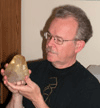
Joined: 29 Dec 2008
Posts: 846
Location: Northeast Ohio



|
 Posted: Jan 05, 2009 14:00 Post subject: Re: Photos of epitaxy - (16) Posted: Jan 05, 2009 14:00 Post subject: Re: Photos of epitaxy - (16) |
|
|
Well, this will be interesting. And gentle. John correctly refers to "very special circumstances" required for two structures to align well enough to form epitactic relationships, and this is quite true. He says the number of orientations in which it can occur is very limited; also true. But in the case of "auto-epitaxy" - growth of a mineral on itself - there is generally only one orientation in which this can occur, and that is when the lattice of the second generation is parallel to the lattice of the first generation. That's a pretty limiting condition! It is true that the growth of the second generation could in principle occur on any crystal face, but only under the condition of lattice parallelism.
Part of the issue here, presumably, is that epitaxy is perceived as involving specific lattice planes in each mineral which have similar configurations - it is a two-dimensional similarity, not a three-dimensional similarity, as is the case with auto-epitaxy. But even when the similarity is confined to specific lattice planes, it is not a foregone conclusion that the faces with the same orientation must be the faces on which the relationship is expressed in the external morphology. The epitaxy of marcasite on pyrite (and vise versa) involves specific planes and directions in each mineral, but this relationship often develops on other planes as well, either because the edge of the epitactic plane of the host is present in the surface of other faces and that is enough to orient the overgrowths, or because the epitactic plane is present as microfacets in a different face which is not a perfect plane at the atomic level. This relationship is even seen in some cases in which the epitactic plane is not expressed at all as a face on the host crystal, at least macroscopically.
The terminology of epitaxy is somewhat messed up. Epitaxy proper refers to two-dimensional relationships. There is a term, monotaxy I think, for one dimensional relationships, but it's not obvious that anyone has come up with a good example. Syntaxy refers to three-dimensional similarities, but the term is also used in other geological contexts to mean quite different things, related to cementation of grains in sandstone, for example. Topotaxy also refers to three-dimensional similarities (usually, at least) but also carries the connotation of a phase change - for example conversion of ilmenite to oriented rutile mats by leaching of iron and recrystallization of rutile at an atomic scale such that the orientation between rutile and ilmenite is preserved even after the ilmenite is gone. Most folks use epitaxy to refer generally to all of these kinds of oriented relationships; I do, and I think John does too.
Three-dimensional similarities are common in epitaxy involving different phases. For example, overgrowths of different rhombohedral carbonates one on the other are common, sometimes without even a change in morphology. If it's calcite in the middle and siderite on the outside, it's epitaxy. Right? The lattices are quite similar in all directions. But what if probe analysis shows that it grades from pure calcite to iron-bearing calcite to calcium-bearing siderite to pure siderite, with no sharp breaks in concentration and no change in morphology. Is it epitaxy or just chemical evolution of a (chemically) mixed crystal? Is it epitaxy if there is a sharp break in composition, or only if there is a change in morphology?
Someone posted here an image of the classic sphalerite/chalcopyrite epitaxy from the Joplin, Missouri area. The chalcopyrite structure is readily derived from the sphalerite structure by replacing the zinc by copper and iron in a systematic way. The relationship is one of three-dimensional similarity. Is it epitaxy? It can be described in terms of any plane in the structure one chooses, because it is more than a two-dimensional relationship. Many, many classic examples of epitaxy turn out to involve structures that are very similar in all directions. If they are epitaxy, then why isn't calcite on calcite?
An aside: I confess that I consider this auto-epitaxy somewhat uninteresting, because the interesting thing about epitaxy is where are the similarities and how similar are they, and there's nothing to figure out when both structures are identical. But I still consider it to be epitaxy.
John raises the question of hopper crystals. I would not call hopper crystals epitaxy, because they do not result (typically, at least) from interrupted growth. Rather, they occur when growth is too rapid to allow new layers on crystal faces to complete themselves and when, because of rates of diffusion, new layers originate near the edges of the crystal rather than across the whole crystal face. Ichiro Sunagawa treats this very nicely in his book, Crystals: Growth, Morphology, and Perfection (Cambridge Press), which I would recommend to anyone interested in these matters of how crystals grow. The difference between hopper growth and the growth in spots along the edges of crystal that I described (sorry, I don't have a good picture) is that in the latter case the morphology and locations of the second generation crystals, and the presence of a dark coating on the first generation crystals, strongly suggests that growth stopped, other materials were deposited on the surfaces of the first generation crystal, and then the growth of the second generation began, but only in very specific places. It is the two-stage growth (with change of morphology as well in this case) that makes these qualify as epitaxy as far as I am concerned. Hoppers result from continued (but compromised) growth, and thus are not epitaxy.
I think that this is a complex matter with a lot of grey area separating cases which are clearly epitaxy and cases which are clearly not. If this is true, what is important is not that John and I agree, but that our discussion leads us to a better understanding of this very interesting and special case of crystal growth.
John, it's your turn!
_________________
Collecting and studying crystals with interesting habits, twinning, and epitaxy |
|
| Back to top |
|
 |
John S. White
Site Admin

Joined: 04 Sep 2006
Posts: 1298
Location: Stewartstown, Pennsylvania, USA



|
 Posted: Jan 06, 2009 06:27 Post subject: Re: Photos of epitaxy - (16) Posted: Jan 06, 2009 06:27 Post subject: Re: Photos of epitaxy - (16) |
|
|
Well, I have to say that I feel a little overpowered here, as I am not nearly the student of crystal structures that Pete is and am already in way over my head.
I would say, however, that the example Pete gave of a gradual chemistry change from calcite to siderite versus a sharp change is a perfect reason to exclude such substances from admission to the epitaxy club. I would suggest that they are no more entitled to admission than are the alternate layers of albite and orthoclase in perthite, due to exsolutiion. Inasmuch as there are already very effective and useful terms to describe both the calcite/siderite relationship, as well as the albite/orthoclase relationship, then I feel it is not necessary to bring them under the umbrella of epitaxy.
If one wants to explain spots of second generation growth along crystal edges as the result of an interrupting coating over the first generation, then one has to ask how was there any second generation growth at all. Why did not the coating cease all growth altogether?
And, while speaking of coatings interrupting growth, I feel I must attach these images of a quartz specimen I have from China. I have written an article about this piece that was published in Rocks & Minerals. There are four generations of quartz crystallization on this specimen. First came the large individual crystals which appear dull gray, then came the clear little windows on pyramid faces, then a coating of chalcedony over the large crystals, but not the little windows, and finally a fine druse of tiny quartz crystals sprinkled over the whole piece. Anyone looking at this just casually would think that steps two and three were reversed, but if that were true then translucent chalcedony would have covered the large crystals entirely and the little windows, if later, would show a film of chalcedony beneath them.
The specimen is from Jinlong, Guangdong Province and the photo were taken by Terry Huizing.
| Description: |
|
| Viewed: |
94907 Time(s) |
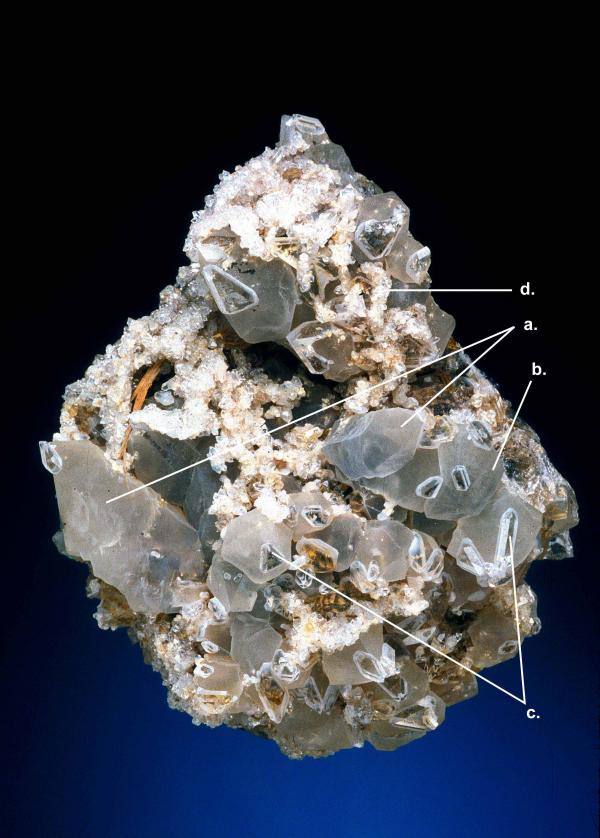
|
_________________
John S. White
aka Rondinaire |
|
| Back to top |
|
 |
John S. White
Site Admin

Joined: 04 Sep 2006
Posts: 1298
Location: Stewartstown, Pennsylvania, USA



|
 Posted: Jan 06, 2009 06:29 Post subject: Re: Photos of epitaxy - (16) Posted: Jan 06, 2009 06:29 Post subject: Re: Photos of epitaxy - (16) |
|
|
There were supposed to be two photos, here is the other one.
| Description: |
|
| Viewed: |
94923 Time(s) |
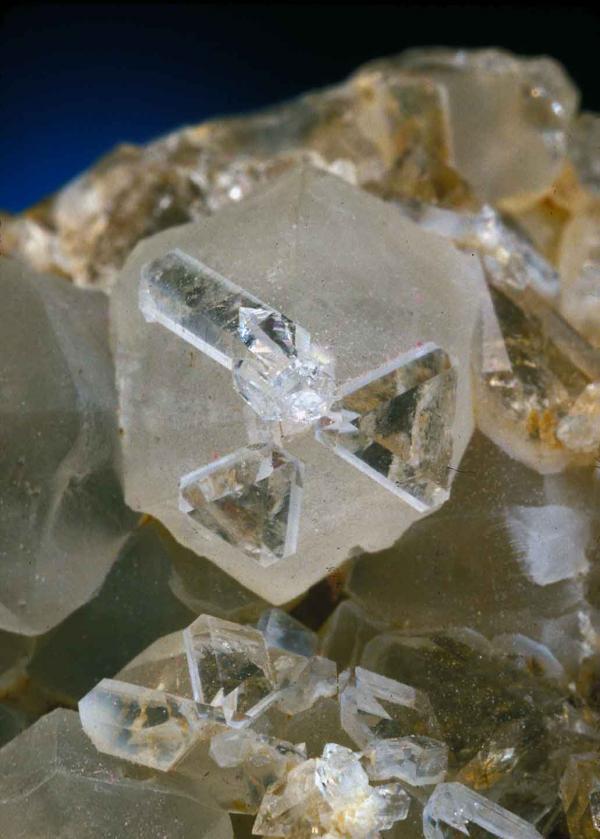
|
_________________
John S. White
aka Rondinaire |
|
| Back to top |
|
 |
Pete Richards
Site Admin

Joined: 29 Dec 2008
Posts: 846
Location: Northeast Ohio



|
 Posted: Jan 07, 2009 09:58 Post subject: Re: Photos of epitaxy - (16) Posted: Jan 07, 2009 09:58 Post subject: Re: Photos of epitaxy - (16) |
|
|
In our dialog on epitaxy involving two generations of the same species, John White wrote "If one wants to explain spots of second generation growth along crystal edges as the result of an interrupting coating over the first generation, then one has to ask how was there any second generation growth at all. Why did not the coating cease all growth altogether?" A good question, as usual.
I think the answer is, first, that sometimes the coating does indeed prevent further growth anywhere on the crystal, in which case the crystal is not favored over any other site on the matrix, and if there is a second generation growth, crystals that form on the first generation crystal are not oriented. But, second, in some cases edges or corners clearly are preferred sites for second generation growth in an oriented fashion. In other cases, certain faces are favored over others. For example, overgrowths may occur only on octahedral faces but not on cube faces on the same crystal. In these cases, I think the reason is that edges and corners have higher surface energy than faces, and are consequently more likely to etch slightly, causing a new clean surface to be exposed to nucleate second generation growth. In the case of growth selectively on certain faces, it may be more a question of the texture of the faces - growth occurring on smooth faces but not on rougher ones or vise versa. It may even involve the chemistry of the faces, since faces in different orientations expose different combinations of atoms.
The attached image shows a second generation calcite crystal growing on the tip of a first generation crystal; several other examples are present in the image but are not easy to see clearly. About half of the first generation crystals on this specimen have similarly located second generation crystals. All have the same orientation relative to the first generation crystals ("auto-epitaxy"). No second generation crystals are found in other locations. The brown color of the first generation is due to a surface coating of unknown composition; this coating is thinner on the small faces that are at the tips of crystals that lack second generation overgrowths. Presumably it is thinner on the ones with second generation overgrowths as well, and this is why the second generation formed at the tips.
Whatever the reason, these selective overgrowths are not uncommon and are very interesting.
| Description: |
| Second generation calcite growing selectively at the tip of first generation crystals. Penske Quarry, near Raymond, Iowa |
|
| Viewed: |
94831 Time(s) |
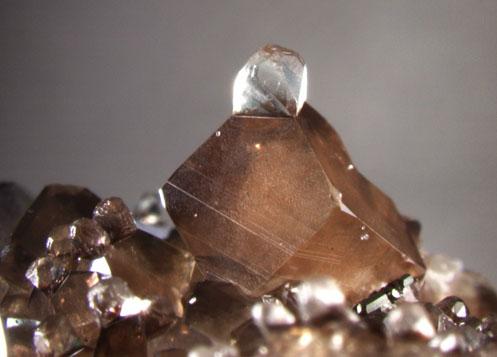
|
_________________
Collecting and studying crystals with interesting habits, twinning, and epitaxy |
|
| Back to top |
|
 |
MineralParagon

Joined: 30 Sep 2008
Posts: 26
Location: Saint Georges es Allier


|
 Posted: Jan 10, 2009 19:36 Post subject: Re: Photos of epitaxy - (16) Posted: Jan 10, 2009 19:36 Post subject: Re: Photos of epitaxy - (16) |
|
|
How can we tell if we have an epitaxy or a post-crystallization?
for e.g., from Italy, I find a quartz crystal with an upper brown shade recovered by a strange crystallization of colorless quartz, like a slight deposit on the tip.
| Description: |
|
| Viewed: |
43535 Time(s) |
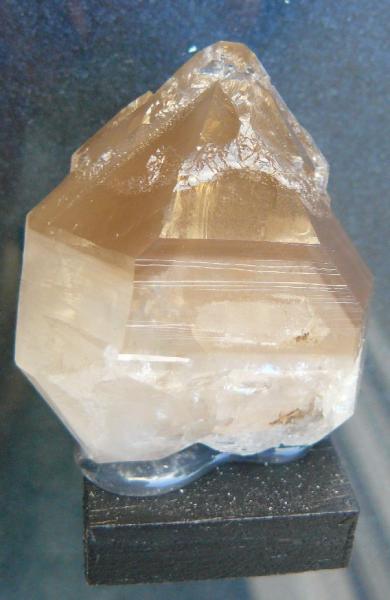
|
_________________
A little piece of mountain, a little peace in me.
Try your best, U'll be happy.
aaaa blog4ever com |
|
| Back to top |
|
 |
John S. White
Site Admin

Joined: 04 Sep 2006
Posts: 1298
Location: Stewartstown, Pennsylvania, USA



|
 Posted: Jan 11, 2009 05:50 Post subject: Re: Photos of epitaxy - (16) Posted: Jan 11, 2009 05:50 Post subject: Re: Photos of epitaxy - (16) |
|
|
Here is a very good example of where Peter Richards and I disagree. I would not call this epitaxy, because it is just secondary growth of one mineral upon the same mineral. Peter, on the other hand, considers this epitaxy. I am not hopeful that this disagreement can be resolved, so it appears that there will be two schools of thought unless and until some authoritative body such as the IMA issues an opinion which either includes or excludes secondary growth as epitaxy. I can only hope that they agree with me. Since such issues are seldom resolved by authoritative bodies, it is more likely that the ambiguity will continue, unfortunately.
_________________
John S. White
aka Rondinaire |
|
| Back to top |
|
 |
MineralParagon

Joined: 30 Sep 2008
Posts: 26
Location: Saint Georges es Allier


|
 Posted: Jan 11, 2009 08:16 Post subject: Re: Photos of epitaxy - (16) Posted: Jan 11, 2009 08:16 Post subject: Re: Photos of epitaxy - (16) |
|
|
What is wonderful is that I agree with your two viewings (John or Peter).
The subject needs a real and probant decision.
Is there the same disagreement for the case of pseudoboleite (no Ag) and boleite (including Ag)? And why cumengeite is existing in sixling and single forms?
| Description: |
|
| Viewed: |
43504 Time(s) |
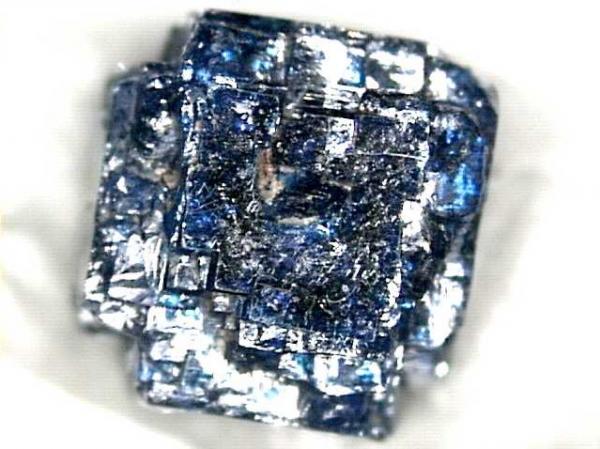
|
| Description: |
|
| Viewed: |
43481 Time(s) |
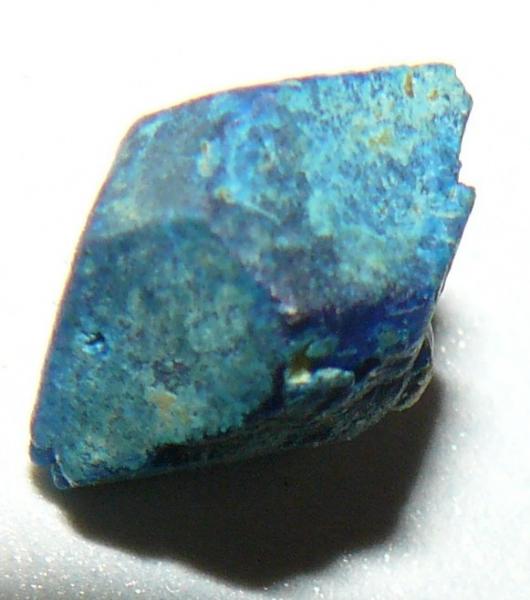
|
_________________
A little piece of mountain, a little peace in me.
Try your best, U'll be happy.
aaaa blog4ever com |
|
| Back to top |
|
 |
parfaitelumiere
Joined: 02 Mar 2008
Posts: 153
Location: Auvergne



|
 Posted: Jan 11, 2009 08:38 Post subject: Re: Photos of epitaxy - (16) Posted: Jan 11, 2009 08:38 Post subject: Re: Photos of epitaxy - (16) |
|
|
I think the same way as John S White regarding epitaxy and second growth on primary growth of the same mineral.
I would tell of epitaxy when there are different species.
However, we often see chemical variations in the same mineral, that creates ghosts or colors, could we talk about epitaxy.
I don't think so, this is the same crystal, the same crystalline system (good word?!), not like an epitaxial growth, where we can have different systems.
|
|
| Back to top |
|
 |
MARION Claude
Joined: 07 Jul 2007
Posts: 5
Location: PARIS


|
 Posted: Jan 11, 2009 09:14 Post subject: Re: Photos of epitaxy - (16) Posted: Jan 11, 2009 09:14 Post subject: Re: Photos of epitaxy - (16) |
|
|
Have you seen "phantom quartz" with a dozen concentric zones underlined by chlorite, liquid inclusions...? The zones outline successive stages of growth. I think that it is not an epitaxy.
I agree with John S White regarding epitaxy.
|
|
| Back to top |
|
 |
chris
Site Admin

Joined: 12 Jul 2007
Posts: 538
Location: Grenoble



|
 Posted: Jan 11, 2009 15:27 Post subject: Re: Photos of epitaxy - (16) Posted: Jan 11, 2009 15:27 Post subject: Re: Photos of epitaxy - (16) |
|
|
Hi folks,
I've found that sentence in a 1977 IMA report about epitaxy :
"Epitaxy is the phenomenon of mutual orientation of two crystals of different species, with two-dimensional lattice control (mesh in common), usually, though not necessarily,
resulting in an overgrowth. (Vote 7-0 in favor.)"
Here I agree with John (sorry Peter). However in the semiconductor world epitaxy often refers as the deposit of a fine layer of the same material as the substrate...
Christophe
|
|
| Back to top |
|
 |
MineralParagon

Joined: 30 Sep 2008
Posts: 26
Location: Saint Georges es Allier


|
 Posted: Jan 11, 2009 15:34 Post subject: Re: Photos of epitaxy - (16) Posted: Jan 11, 2009 15:34 Post subject: Re: Photos of epitaxy - (16) |
|
|
This seems to be the most precise definition. Thanks for your search and definition!
_________________
A little piece of mountain, a little peace in me.
Try your best, U'll be happy.
aaaa blog4ever com |
|
| Back to top |
|
 |
Linda St-Cyr

Joined: 29 Oct 2008
Posts: 34
Location: Sparks, Nevada & on the road!



|
 Posted: Jan 11, 2009 17:28 Post subject: Re: Photos of epitaxy - (16) Posted: Jan 11, 2009 17:28 Post subject: Re: Photos of epitaxy - (16) |
|
|
I still think that the term "auto-epitaxy" is clear and serves a purpose, however.
_________________
Linda St-Cyr |
|
| Back to top |
|
 |
Pete Richards
Site Admin

Joined: 29 Dec 2008
Posts: 846
Location: Northeast Ohio



|
 Posted: Jan 12, 2009 20:23 Post subject: Re: Photos of epitaxy - (16) Posted: Jan 12, 2009 20:23 Post subject: Re: Photos of epitaxy - (16) |
|
|
John White and I agreed separately to wind down our discussion, feeling it had produced about as much good as it can. So as my final message on this thread, I will make a couple of comments to respond to more recent contributions prompted by our exchange.
First, I agree with John about the smoky quartz that MineralParagon posted, i.e., that this is not a clear case of auto-epitaxy. For one thing, the smoky color is either a phantom some distance below the surface of the crystal or is a characteristic of the outer (1mm?) layer. It is not a surface coating. Therefore, it would not inhibit growth, and it is not strong evidence of a two-stage growth process. I recognize that establishment of the concept of auto-epitaxy extends the concept into a grey area, but I think it can be useful. But in addition, it must be applied judiciously!
About pseudoboleite and boleite, I think it is well established that this is a good example of classic epitaxy. Same comment about cumengite - usually as "sixlings" epitactic on boleite but can occur alone. These are epitactic groups, not twins, that's why I put sixlings in quotes.
To a couple of posts which raise the question of phantoms or growth layers, I would agree that these are not clear indicators of a two-stage growth process, and don't deserve to be called epitaxy.
To Chris quoting the 1977 IMA report: this is exactly the source I was referring to when I wrote earlier of the various forms of "-taxy", i.e., monotaxy, epitaxy, syntaxy, and topotaxy. This report is, I suppose, the "law" about these terms, but it is also 31 years old, and my experience is that usage among crystallographers has changed, even if the law has not. Or has decided to ignore the "law". Chris refers to the strict version of epitaxy; I use it more loosely to refer to all oriented overgrowths, but with the restriction that "overgrowth" MUST mean two stages of growth. And if one cannot infer that there were two stages of growth from the morphology, then the term epitaxy should not be applied to crystals of only one species.
To all, thanks for your interest in this discussion. I hope we have all gained some thoughts worth pondering, and some advance in our thinking about the fascinating question of how crystals grow.
_________________
Collecting and studying crystals with interesting habits, twinning, and epitaxy |
|
| Back to top |
|
 |
chris
Site Admin

Joined: 12 Jul 2007
Posts: 538
Location: Grenoble



|
 Posted: Jan 13, 2009 10:31 Post subject: Re: Photos of epitaxy - (16) Posted: Jan 13, 2009 10:31 Post subject: Re: Photos of epitaxy - (16) |
|
|
Hi Pete,
Thanks for your comments and for posting the thread. I really enjoyed reading it.
Christophe
|
|
| Back to top |
|
 |
|





